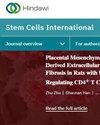The Neural Progenitor Cell-Associated Transcription Factor FoxG1 Regulates Cardiac Epicardial Cell Proliferation
IF 3.8
3区 医学
Q2 CELL & TISSUE ENGINEERING
引用次数: 0
Abstract
The epicardium is a layer of mesothelial cells that covers the surface of the heart. During development, epicardial cells undergo epithelial-to-mesenchymal transition (EMT) to form multipotent precursors that migrate into the heart and contribute to the coronary vasculature by differentiating into adventitial fibroblasts, smooth muscle cells, and endothelial cells. Epicardial cells also provide paracrine signals to cardiac myocytes that are required for appropriate heart growth. In adult hearts, a similar process of epicardial cell EMT, migration, and differentiation occurs after myocardial infarction (MI, heart attack). Pathological cardiac hypertrophy is associated with fibrosis, negative remodeling, and reduced cardiac function. In contrast, aerobic exercises such as swimming and running promote physiological (i.e., beneficial) hypertrophy, which is associated with angiogenesis and improved cardiac function. As epicardial cell function(s) during physiological hypertrophy are poorly understood, we analyzed and compared the native epicardial cells isolated directly from the hearts of running-exercised mice and age-matched, nonrunning littermates. To obtain epicardial cells, we enzymatically digested the surfaces of whole hearts and performed magnetic-activated cell sorting (MACS) with antibodies against CD104 (integrin β4). By cDNA microarray assays, we identified genes with increased transcription in epicardial cells after running exercise; these included FoxG1, a transcription factor that controls neural progenitor cell proliferation during brain development and Snord116, a small noncoding RNA that coordinates expression of genes with epigenetic, circadian, and metabolic functions. In cultured epicardial cells, shRNA-mediated FoxG1 knockdown significantly decreased cell proliferation, as well as Snord116 expression. Our results demonstrate that FoxG1 regulates epicardial proliferation, and suggest it may affect cardiac remodeling.神经祖细胞相关转录因子 FoxG1 调控心脏外膜细胞增殖
心外膜是覆盖在心脏表面的一层间皮细胞。在发育过程中,心外膜细胞经历了上皮细胞到间质细胞的转变(EMT),形成多能前体,移入心脏,通过分化为心外膜成纤维细胞、平滑肌细胞和内皮细胞,为冠状动脉血管做出贡献。心外膜细胞还向心肌细胞提供心脏正常生长所需的旁分泌信号。在成人心脏中,心肌梗塞(MI,心脏病发作)后也会发生类似的心外膜细胞 EMT、迁移和分化过程。病理性心脏肥大与纤维化、负重塑和心功能减退有关。相比之下,游泳和跑步等有氧运动会促进生理性(即有益的)肥厚,这与血管生成和心功能改善有关。由于对生理性肥厚过程中心外膜细胞的功能知之甚少,我们分析并比较了直接从跑步锻炼小鼠和年龄匹配的非跑步小鼠心脏中分离出来的原生心外膜细胞。为了获得心外膜细胞,我们酶解了整个心脏的表面,并用抗 CD104(整合素 β4)的抗体进行了磁激活细胞分选(MACS)。通过 cDNA 微阵列分析,我们确定了跑步运动后心外膜细胞中转录增加的基因,其中包括 FoxG1(一种在大脑发育过程中控制神经祖细胞增殖的转录因子)和 Snord116(一种协调具有表观遗传、昼夜节律和新陈代谢功能的基因表达的小型非编码 RNA)。在培养的心外膜细胞中,shRNA 介导的 FoxG1 基因敲除显著降低了细胞增殖和 Snord116 的表达。我们的研究结果表明,FoxG1 可调控心外膜增殖,并可能影响心脏重塑。
本文章由计算机程序翻译,如有差异,请以英文原文为准。
求助全文
约1分钟内获得全文
求助全文
来源期刊

Stem Cells International
CELL & TISSUE ENGINEERING-
CiteScore
8.10
自引率
2.30%
发文量
188
审稿时长
18 weeks
期刊介绍:
Stem Cells International is a peer-reviewed, Open Access journal that publishes original research articles, review articles, and clinical studies in all areas of stem cell biology and applications. The journal will consider basic, translational, and clinical research, including animal models and clinical trials.
Topics covered include, but are not limited to: embryonic stem cells; induced pluripotent stem cells; tissue-specific stem cells; stem cell differentiation; genetics and epigenetics; cancer stem cells; stem cell technologies; ethical, legal, and social issues.
 求助内容:
求助内容: 应助结果提醒方式:
应助结果提醒方式:


